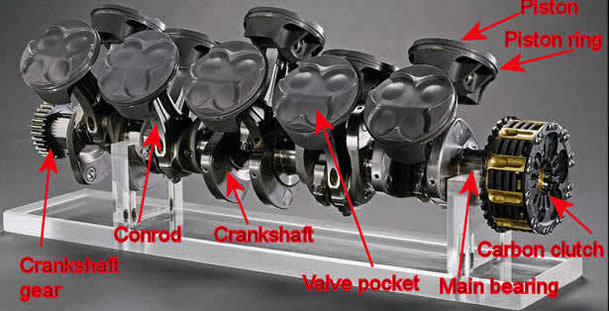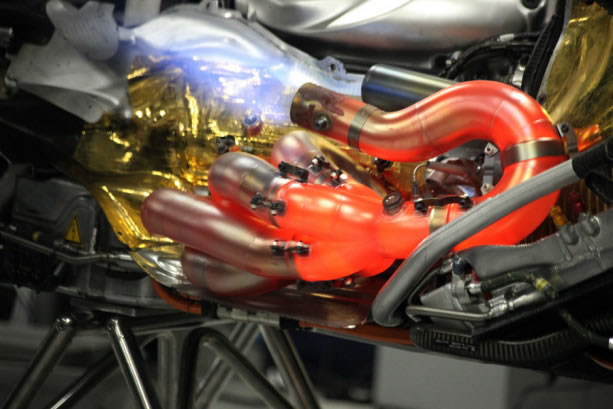Formula 1 Engine
To learn more about new 2014 rule change and new Formula 1 Power Units and ERS System follow this link.
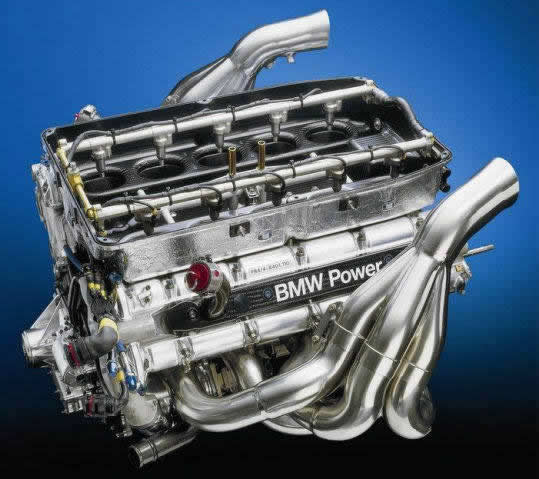
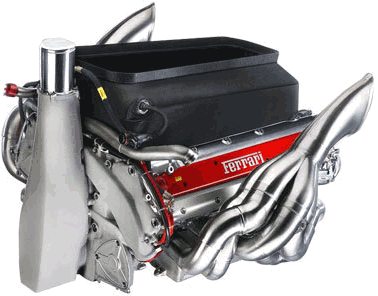
Very sophisticated and expensive part of equipment. Modern F1 engine is 2.4 liter V8 engine. Highly limited in development by FIA rules, engine is subjected to development freeze for next 5 or 10 years (to be decided).
In the 1950s Formula One cars were managing specific power outputs of around 100 bhp / liter (bhp per liter); about what a modern road car can manage today.
During a 'turbo age' of 1.5 liter turbo engines, some of them were producing anything up to 750 bhp / liter.
Once the teams started using exotic alloys such as titanium and beryllium in the late 1990s, the FIA banned the use of exotic materials in engine construction, and only aluminum and iron alloys were allowed for the pistons, cylinders, connecting rods, and crankshafts. First in this field was Ilmor, producer of the Mercedes V10s used by McLaren. Since 1998, Ilmor has manufactured pistons from an aluminum-beryllium alloy, thereby reducing their weight by a third, possibly more, and gaining enhanced thermal conductivity. The cost of this alloy, and the fact that fine beryllium dust particles arguably constitute a health hazard, has led to an effective ban on its use, imposed by the FIA. Under pressure from McLaren and Mercedes, however, this ruling, for which Ferrari lobbied hard, has been postponed to the end of season 2002.
The basic configuration of a naturally aspirated Formula One engine has not been greatly modified since the 1967 Cosworth DFV and the mean effective pressure has stayed at around 14 bar MEP. Until the mid-1980s Formula One engines were limited to around 12,000 rpm due to the traditional metal valve springs used inside the engine to close the valves. The speed required to operate the engine valves at a higher RPM is much greater than the metal valve springs can achieve and they were replaced by pneumatic valve springs introduced by Renault. Since the 1990s, all Formula One engine manufacturers now use pneumatic valve springs with the pressurised air allowing engines to reach speeds nearly 20,000 rpm.
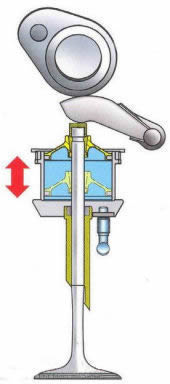 Thet was a real breakthrough. Pneumatic valve actuation offers precision of control, even at 20,000rpm, and consequently is now universal in Formula l.
Thet was a real breakthrough. Pneumatic valve actuation offers precision of control, even at 20,000rpm, and consequently is now universal in Formula l.
Almost each year the FIA has enforced material and design restrictions to limit power, otherwise the 3.0L V10 engines would easily have exceeded 22.000 rpm and well over 1000hp (750kW). Even with the restrictions the V10's in the 2005 season were reputed to develop 960hp (715kW), more than 300 bhp / liter.
Since 2006, the regulations have required the use of 2.4 liter V8 engines, with power outputs falling around 10 percent. The new 2.4L V8 engines are reported to develop between 720hp and 750hp (535 to 560 kW, thats mean 300hp (224 kilowatts) per litre of displacement, far higher than most naturally aspirated internal combustion engines.), with the Williams Cosworth unit from 2006 being the most powerful. By the FIA rules, 8 units per driver have to last all season, and it is interesting to see that highest use individuall engine can do a total of 3,073 kilometres, which includ all of the season races as well as six Friday practice sessions. Number of engines per seasson later was reduced to six, and for 2014 to five. Teams always plan to use a new engine for Turkey, Spa and Monza in particular and these units would probably not do a third race. Each one of a driver’s new engines is given a shakedown test on the dyno for 150 kilometres before going off the race track to be fitted into a car.
It’s amazing to look back on the days when each team would bring as many as 10 engines to each race and bolt in a fresh one every day. What has come with the freeze in V8 engine regulations is a deeper understanding of the engines, which has brought amazing reliability. The ceramic pistons today, for example, are lighter than those on qualifying engines of 10 years ago when they were just about strong enough to last for an hour’s qualifying session. And yet now they last 3,000kms!
The imense power a Formula One engine produces is generated by operating at a very high rotational speed, up to 18,000 revolutions per minute (RPM). This contrasts with road car engines of a similar size which operate safely at typically less than 7,000 rpm. However, the torque (turning force at a given speed) of a Formula One engine is not much higher than a conventional petrol engine. For example, the 2006 2.4 litre Toyota RVX-06 V8 engine produces 552 kW (740 bhp) at 19,000 rpm and outputs 274 Nm of torque giving the engine a 14.3 bar (1.43 MPa) mean effective pressure. This is less than the 15.1 bar maximum MEP of the 2009 Ferrari 458 Italia, the best production car in this respect. Consequently, high power is obtained by making an engine turn faster.
Another challenge during 2011 season was dealing with simultaneous KERS and DRS deployment without hitting the rev limiter on the straights. This was done through gearing, of course, because interestingly simultaneous deployment of DRS and KERS adds an extra 1,000 revs at the end of the straight and you don’t want to hit the rev limiter because that adds 15-20% more engine stress.
 |
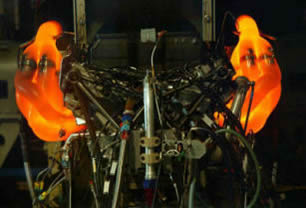 |
Formula 1 engine on dynamometric test bench, and enormous heat from exhaust of an F1 engine. But dynos can only tell you so much, there is little substitute for the real world testing. |
|
First Formula One engine to reach 20,000 rpm on track was Cosworth CA in 2006. From 1906 through to 2006, Grand Prix engine speeds rose ever higher, from less than 2000 rpm to ultimately a mind-boggling 20,000 rpm. Then the rule-maker abruptly halted the march of progress with a 19,000 rpm rev limit for 2007, subsequently reduced to the current 18,000. It is generally agreed that no rival surpassed it as the benchmark before rev limiting was imposed.
It is widely agreed that BMW reached 19,000 rpm first, in 2002. However, engine mileage requirements were lengthened in 2004 and 2005, which had the effect of pegging the ongoing crankshaft speed rise. Representative of the top 2005 V10s was the Toyota that ran to a maximum of 19,200 rpm and produced an estimated 930 bhp mid-season. All of the 2005 V10s exceeded 900 bhp but it is not thought that any exceeded 950 bhp, with the possible exception of the Honda at the end of the season.
Cosworth's 2005 V10 was the TJ model, which had its max RPM at 19,000 rpm. With next year model CA, Cosworth took the uncompromising approach of targeting 20,000 rpm from the outset. This was the first time it had produced such a high-speed V8. At 20,000 rpm the CA's maximum piston acceleration was 10,616 g while the load imparted on each crankpin by the associated piston and con rod reached a very substantial 5937 kg at that unprecedented speed. To put that into context, an anti-ballistic missile attains a g-force of only 100 g while 5937 kg is approximately two and a half times the weight of a Rolls Royce Wraith! Cosworth, to counteract high friction that can counteract horsepower gain, applyed a Diamond-Like Carbon (DLC) coating to the piston skirts.
Revving to 18,000 RPM, a modern Formula One engine will consume a phenomenal 450 liters of air every second, with race fuel consumption typically around the 65 l/100 Km. Revving at such massive speeds equates to an accelerative force on the pistons of nearly 9000 times gravity (9000 G).
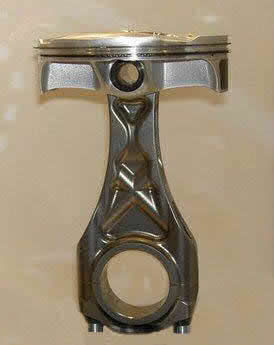 |
Formula 1 piston |
Of course, the biggest challenge has been holding everything together as reciprocating and rotating parts are worked ever faster, and generate increasingly fierce loadings. Even at "only" 12,000rpm there are seven tons of load going up a con rod, which responds by growing longer, then 12 tons going down it, which unavoidably shortens it somewhat! F1 piston travels only about 40 millimeters and acceleration from 0 to 100kmh has been measured at 0.0005 seconds. The bore is roughly 98 millimeters (called supersquare bore (wider than higher)).
The engines produce over 100,000 BTU per minute (1,750 kW) of heat that
must be dumped, usually to the atmosphere via radiators and the exhaust, which can reach temperatures over 1,000 degrees Celsius. Nonetheless a Formula One engine is over 20% more efficient at turning fuel into power than even the most economical small car. Unsurprisingly, engine-related failures remain one of the most common causes of retirements in races. The engine oil capacity is about 3 litre or so. This is because of the dry sump system.
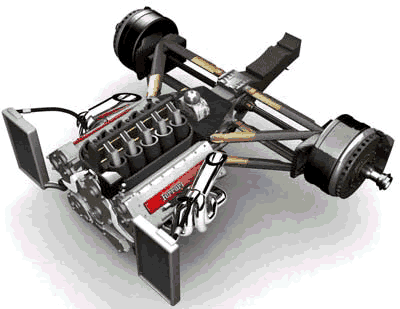
The engine is a stressed component within the car, bolting to the carbon fiber 'tub' and having the transmission and rear suspension bolted to it in turn. Therefore it has to be enormously strong. But a conflicting demand is that it should be light, compact and with its mass in as low position as possible, to help reduce and lover car's centre of gravity and to enable the height of rear bodywork to be as low and compact as possible. Again, this kind of engine arrangement was invention of Colin Chapman. Chapman was on the look out for a new engine for 1967, but he struggled to find one. He then contacted his old friends Mike Costin and Keith Duckworth, the founders of the Cosworth engine tuning company. Using a Ford four cylinder as a base, the Cosworth team first developed a 16-valve 1600 cc FVA engine for Formula 2. It would form the basis for the three litre V8 readied for the 1967 season. Dubbed the DFV (Double Four Valve), the new engine was completely cast from aluminium in the Cosworth factory. Cosworth DFV was exceptionally rigid and Chapman used this to the fullest when he designed the Lotus 49 F1 car. The race car used an aluminium monocoque chassis that stretched no further than the bulkhead behind the driver. The new V8 was bolted directly onto this chassis and took all of the rear suspension load, which was a much lighter and cleaner solution than using a rear subframe.
 |
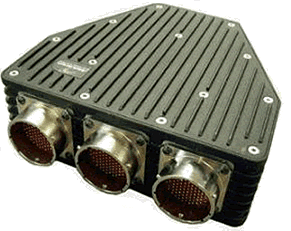 |
Old TAG-McLaren Engine Management System, and "new" common "MES-Microsoft-McLaren Electronic Systems" TAG-310B ECU common ECU -Electronic Control Unit- used, by the FIA rules, in all F1 cars. Produced in cooperation by McLaren and Microsoft. Having run the McLaren Electronics Systems TAG-310B ECU since 2006, teams will have an upgraded ECU to run in 2013. The TAG-320 is the same physical size, but has far greater performance and more interfaces. Although useful, for 2013 this has no real impact on the teams, as the ECU is aimed at supporting the complex "power units" to be introduced in 2014. |
|
On a typical race weekend in Europe, every team brings about 5 engines and 8 engine people which includes race engineers who fine-tune the engine for every part of the track and software specialists to look after the hundreds of sensors associated with the complex engine management system. Although the solutions to producing a winning engine are shrouded in secrecy, the basic design parameters for a modern F1 engine are well understood. The engine's centre of weight should be as low as possible, some teams like Renault in 2001 went with 111 degrees V angle to lower the engine to the track. The production of torque/power needs to be smooth and responsive across the largest possible rev range, the dimensions of the engine should be as compact as possible, and it needs to be reliable in the harsh racing environment.
The engine startup procedure, includes their preliminary systems check-ups with system laptop computer, along with priming the engine with oil. Also the engine needs to be at 80 deg C, before they can start it up. The really tight tolerances need to open up, before they can fire up the engine, or it would simply seize. They pump heated water through the system. Cooling system runs water only, along with some corrosion inhibitors.
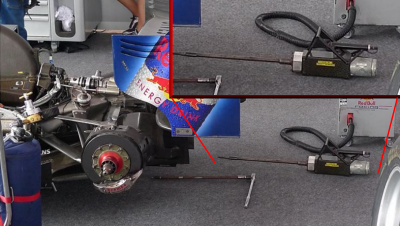
Left: Before they plug the starter motor into the gearbox, they run a manual check with a ratchet spanner and an attachment similar to the starter socket. This is to check that the pneumatic systems on the valvetrain are working properly and engine is not seized and need more heating. In case of an issue with a system, some malfunction like an open valve could spell disaster for the engine.
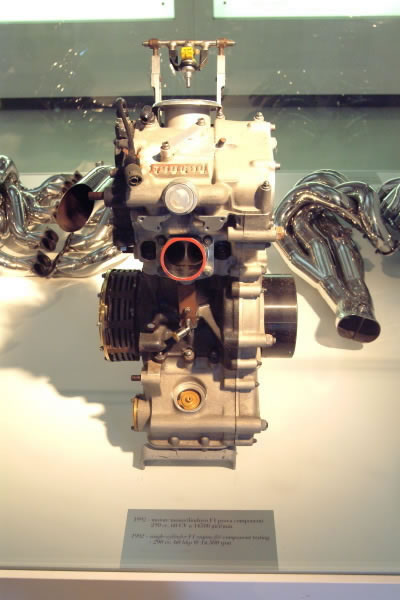
One cylinder engine in Ferrari museum.
Produced 1992, 290ccm, 14.500RPM
Production and testing of an F1 engine start with one cylinder model. Basically that is cutt-off 1 cylinder of real engine to be. Full sized engine will be too expensive to build only for basic testing in beginning of development of an engine. On this model, engineers can see all good and bad things in concept and modify parts to find solutions for the problems. They can see quality of fuel explosion inside cylinder chamber, measure propagation, speed and distribution of exploded gases, measure vibrations. With one cylinder engine like this is much cheaper and faster to make any modification.
Pistons, Crankshaft and Clutch
Engine Head

Oil sump Housing with Alternator and Hydraulic Pump
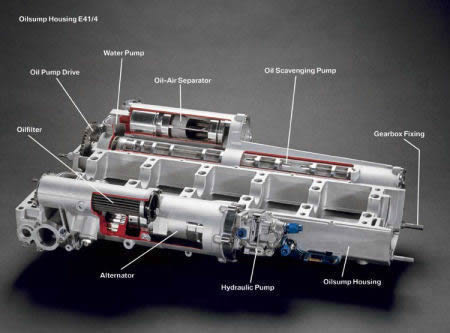
Crankshaft
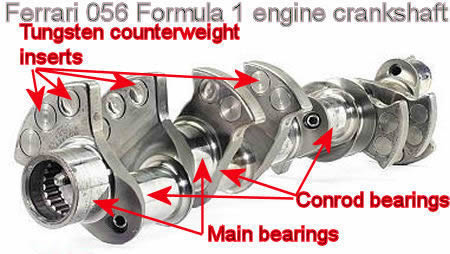
And everything is driven with Timing Gears powered by crankshaft gear

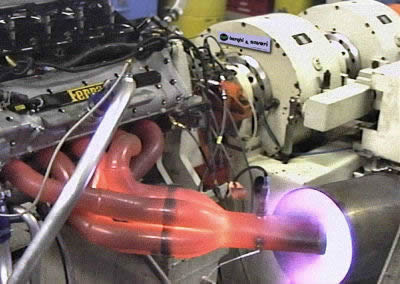 |
|
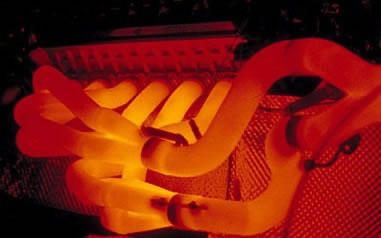 |
|
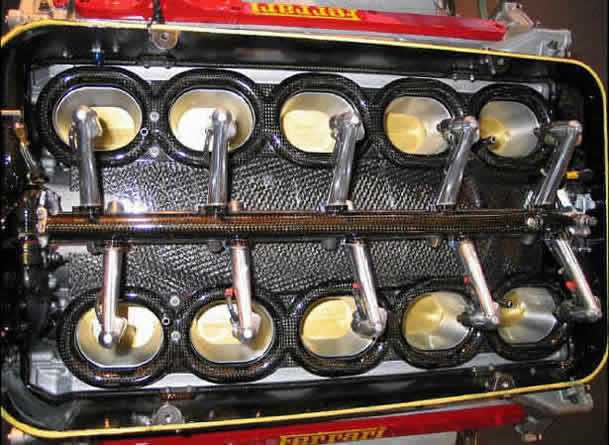
Injectors on Ferrari V10 formula 1 engine, compared with
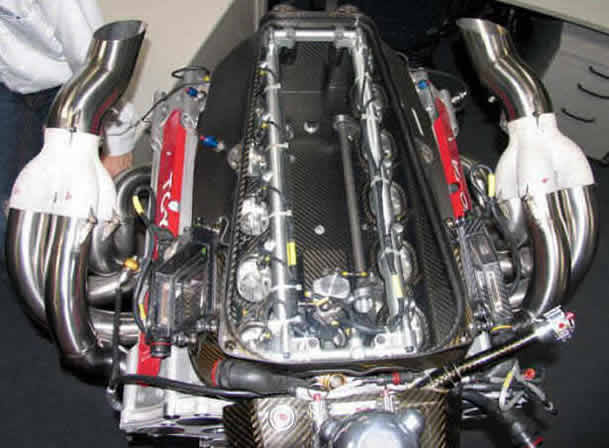
Toyota Formula 1 V10. Difference in rail arrangement

Piston head in Formula 1 is on limit, very light
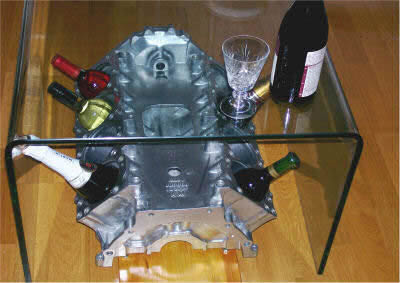
Ford Cosworth, 8 cylinder engine, 2,4 liter, produced 2003, still in use
Red Bull revs one of its Renault V8 engines to destruction after the race in Brazil 2013
Most complicated Formula 1 Engine ever!
Numbers on a typical race per Grand Prix:
Number of combustions in a GP: 8 million
- Number of engine & vehicle measurements/second at top speed: 150,000
- Maximum rpm: 18,000
- Number of individual parts: 5,000 approx
- Number of different parts: 1,000 approx
- Maximum exhaust temperature (in a race): 800° Celsius
- Number of liters of air aspirated in 1 second at top speed: 650
- F1 engines built in a year: 1000
- Weight in kg: less then 90
- Engine assembly hours: 80
- Hours checking a new cylinder head with computer tomography: 20
- Number of engines brought to each GP: 5
- In terms of specific fuel consumption - power per litre of fuel burnt - an F1 engine is 20% more efficient than that in a small-capacity road car such as a Ford Fiesta or Renault Clio, and produces about the same amount of CO2 per kg of burnt fuel.
- In an 18-race season, the entire F1 grid burns the same amount of fuel as a Boeing 747 does in one flight from London to Japan.
Numbers on a typical UBS CHINESE GRAND PRIX (Shanghai)
The back straight at Shanghai International Circuit covers 1170m, equivalent to 21.4 percent of the total lap distance. This is the longest straight encountered during the 2011 Formula One season, closely followed by Abu Dhabi’s Yas Marina (1140m), Italy’s Monza (1120m) and Korea’s Yeongam (1050m). The engine spends a full 17 seconds at wide open throttle, which represents approximately 18 percent of last year's pole position time. This is the second longest period at wide open throttle of any circuit: it is exceeded only by Spa, where the run from La Source to Les Combes (including Eau Rouge) lasts for 23.5 seconds (Monaco has the shortest: 7.5 seconds). In terms of the percentage of the lap spent at wide open throttle, Shanghai is actually among the least demanding circuits of the year: 62 percent of the lap compared to the maximum value of 83 percent in Monza.
A piston will complete over 12,000 cycles, and the crankshaft 24,000 rotations, during every lap in Shanghai - this can be translated to nearly 2km of distance travelled by the piston. Out of that, 450m are accounted for in the back straight. At peak revs, the pistons will be subjected to accelerations of 81,000m/s2. This acceleration equates to more than 8,250G and the force held by the piston exceeds 50kN - equivalent to the weight of more than three standard road cars. For the valves, life is even tougher: they experience higher accelerations, with impact pressures almost 30 times greater than those endured by the pistons during combustion.
At 18,000 rpm, the engine admits around 450 liters of air per second - which would equate to 27,000 liters per minute at maximum revs. By way of comparison, a Mercedes-Benz C-Class Estate has a load capacity of 485 liters.
From year 2009, new FIA rules stipulate one engine for three races. Until now it was stipulated to use engine for two races. In a move designed to boost reliability still further, rev limits will be cut from 19,000 to 18,000 rpm. Teams will be limited to eight engines per season - eight for each race driver and an additional four for testing. Just one team - Renault - has been allowed to make performance modifications to their engine for 2009 and again in 2010 in order to help equalise power outputs.
The sport will switch from the current 2.4-litre V8s to 1.6-litre four-cylinder turbo engines with energy recovery systems and fuel restrictions. The new rules could be confirmed by governing body the FIA on 10 December 2010.
The move was opposed for some time by Mercedes and Ferrari because they felt it did not make any sense to commit to spending millions designing a new type of engine at a time when the sport was trying to cut costs, and teams were facing problems finding sponsorship as the global economic crisis bit.
F1 commercial boss Bernie Ecclestone put it this way to me when I spoke to him about the prospect of the new rules: "It's not necessary. We have a very good engine formula. Why should we change it to something that is going to cost millions of pounds and that nobody wants and that could end up with one manufacturer getting a big advantage?
"We don't need to do it; all the manufacturers are doing it (in their road cars) already."
- 1.6-litre, six-cylinder single-turbos with energy recovery and fuel restrictions to replace current 2.4-litre normally aspirated V8s
- Fuel efficiency to increase by 35 - 40%
- Maximum revs of 15,000rpm
- Power of energy-recovery systems to double
- Overall power to remain at approx 750bhp
- Checks and balances to ensure costs are contained and performance across all engines remains comparable
- Plan for advanced 'compound' turbos to be introduced in subsequent years
The new generation of F1 engines for 2014 is small capacity single turbo V6 engines. They will turn the page as far as engine technology is concerned and will re-introduce engines as performance differentiators, at least to start with. Without getting too technical, Article 1.22 of the Technical Regulations now refers to what's called a 'Power Unit'. This comprises an ICE (Internal Combustion Engine, traditional engine), an ERS (Energy Recovery System) and all the ancillaries needed to make them work. But why a Power Unit? Well, today's V8 essentially features a "bolt-on" KERS Hybrid system that was added during the engine's life. The 2014 Power Unit has been designed with integrated hybrid systems from the very beginning.
However, great care has been taken by both the FIA, the manufacturers and the teams to ensure that the new engine formula doesn’t turn into a spending war. Many areas of the engine architecture are fixed, such as the bore size, the crankshaft height, the single turbo and so on. The key to building a great engine rather than just a good one will be getting power from the given fuel flow. The engines will be high revving. You don’t get the maximum fuel flow rate until you are above 10,500rpm, and the maximum revs are at 15,000rpm. Engine has 15% less moving.
One important aspect of change will be to see the “power unit” as a whole entity, so that each driver will have 5 “power units” for the season (currently he has 8 engines). So if he has a failure of ERS, turbo, an exhaust, battery or control electronics failure you will have to use a sixth power unit and incur a 10 place penalty. Today it’s only the engine itself which attracts a penalty.
Whereas today’s engines need to last for 2,000kms, the 2014 units will therefore need to last for 4,000 kms, which interestingly also makes them usable in the Le Mans 24 hours race.
KERS will be dropped in favor of ERS (Energy Recovery System), which will store and inject 120kW of power back into the engine, which will make a huge difference. Whereas KERS isn’t that noticeable, ERS will make a very significant difference to lap time. Heat recovery from the exhaust is part of a system which will harvest five times the energy KERS does currently. This is one of the key areas of development. To addition to single KERS system used today, which gives around 80hp boost for 7 seconds per laps, the 2014 units will also harvest energy from ERS. It's like KERS on steroids. They will still be able to harvest energy from and deploy energy to the rear axle, and to addition to that they can now do the same from the turbocharger. The kinetic machine is called MGUK (Motor Generator Unit Kinetic) and the machine on the turbo an MGUH ('h' for heat). All of which will boost the output to 161hp for 33 seconds per lap (4MJ compared to 400 kJ). The unit can store 10 times more energy than the current KERS units and harvest 5 times more energy at the rear axle. Current thermal efficiency is 30%, and Mercedes has said that it is aiming for a thermal efficiency of 40% with its new turbo engine - a figure markedly more efficient than even the best road-car diesel engines, which are in the region of 35%. As the driver on average demands full power for 50 seconds per lap, this means that the hybrid aspect will be a very significant contributor to lap time.
For 2014, the rules specify a maximum race fuel allowance of 100 kg - compared to a typical race fuel load of around 150 kg before 2014 (although that 150kg are not fixed by the rules) so the engineers need to find a 30% improvement in efficiency compared to today’s engines, while maintaining the same power output. The 2014 engines will use Direct Injection, pressurized to 500bar. The regulations are aimed at reducing fuel consumption, with savings of 35% on the current fuel usage, which will save around 55kg of fuel per car per race.
But the rules also allow the engineers some freedom to innovate, with certain key parameters controlled, which seems like a good compromise. Another important point is that with the engine architecture fixed, it’s easy for teams to switch from one manufacturer to another if they find they aren’t competitive. This will keep the engine builders on their toes.
With the new generation hybrid devices and because of turbocharger, the engine is going to produce a lot more torque than the V8 and over a wider power band, and this will lead to the cars stepping out more at the rear as they exit corners, That means the car is going to be grip limited on corner exit. Getting on top of that will be important, but so will the efficiency of the power units themselves. The pressure will be on tire supplier Pirelli to produce tires that can cope with the increase in sliding.
There will be a single exhaust, exiting down the centre of the engine cover, onto the rear wing. This will make exhaust blowing into the diffuser a huge challenge, but as the gains are so great it will be fascinating to see how the aerodynamicists manage to channel the air.
As for many fans’ fears that the sound will be disappointing, with a rev limit of 15,000 the engines will scream and with six exhaust pipes going into one turbocharger engine will sound very nice. It is noticeably less of a high-pitched wail at peak revs, as the maximum is now 15,000rpm, rather than the 18,000 previously. And the turbo, which revs to a maximum 125,000rpm will also be audible. The engine note will not be as loud as the V8 because of two factors: the lower engine speed and the fact that the turbocharger sits in the exhaust flow, recovering energy from it that would otherwise be lost as heat and sound, and muffling it.
The manufactures have agreed to homologate the engines on March 1st 2014, so they have until then to develop them.
To learn more about:
2014 Formula 1 Power Unit with ERS
F1 Engine rule change trough the years
Formula 1 engine supplier history

